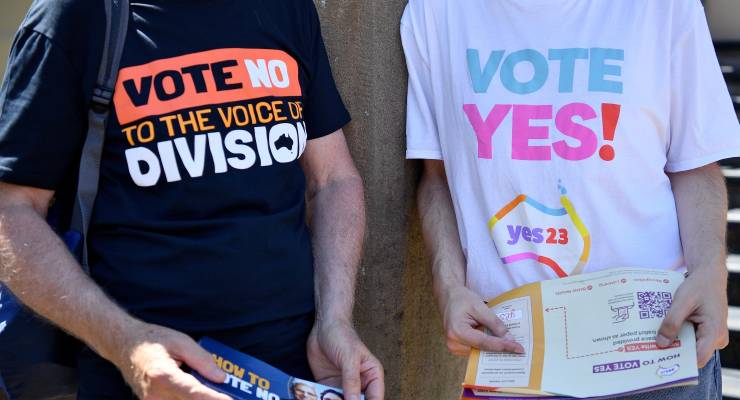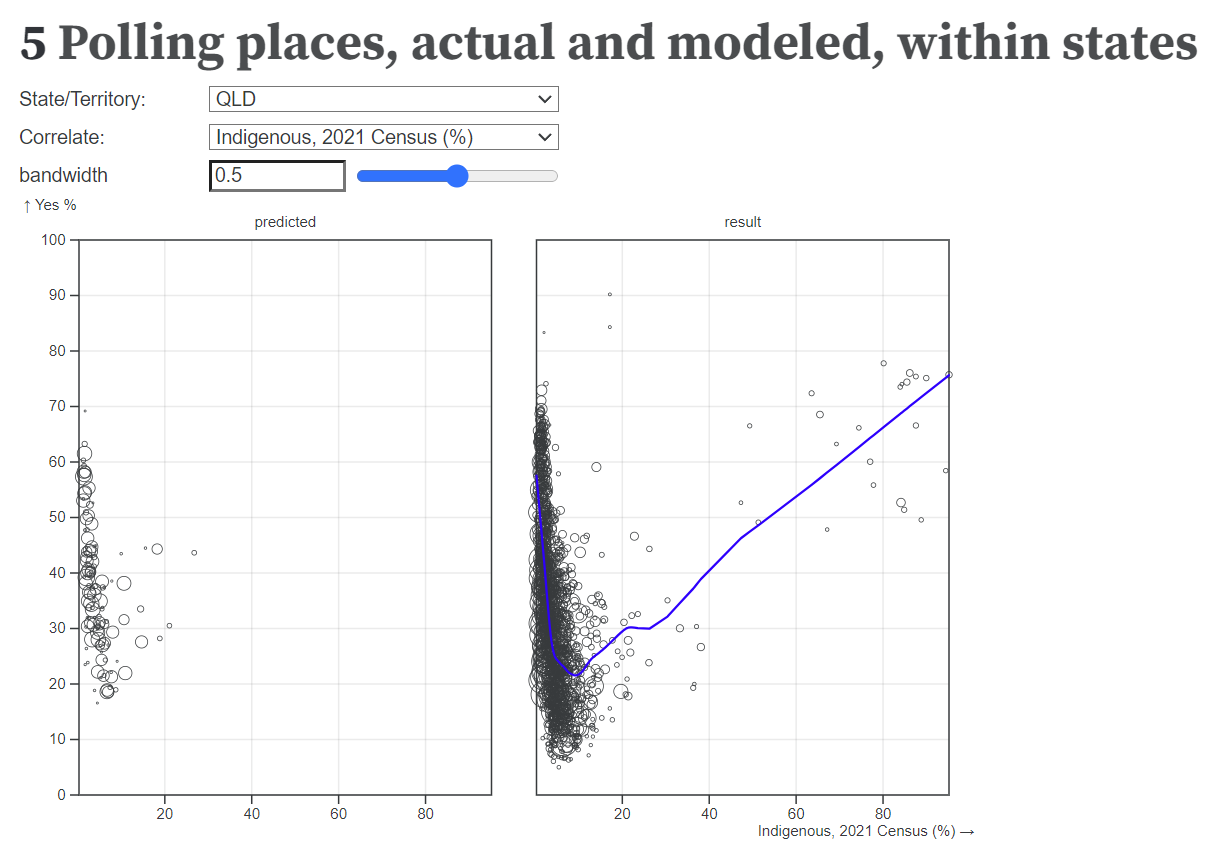
I started following the Voice polls at the end of last year. After Opposition Leader Peter Dutton announced the Coalition’s formal opposition to the Voice to Parliament, I wrote this (which I believe to be the first psephology article that tracked the Voice support) and I made this baby Voice two-answer graph:

I found it interesting that the fall seemed to be accelerating, given I had seen Peter Brent’s pieces from January that suggested that the Voice was doomed. I felt that putting a curved trendline on it was a bit out on a limb (it’s only 16 data points), but I put it out there like that anyway.
At this stage it still seemed possible the decline would pull up, but as it accelerated it became clear Yes was in a lot of trouble. By the time of this second article, Yes was at 54%.

And on it went as this amazing carnival of polls brought more and more information, but still there was never any point at which the decline actually stopped (towards the end it slowed a bit, though only after applying large corrections for apparent house effects).
Finally I ended up with this, where the Yes vote looks like what happens if you throw a rock out a fourth-storey window horizontally. Trying to save the Voice was like fighting electoral gravity.

Indigenous support levels
The matter of Indigenous support levels for the Voice was always going to be much scrutinised after the event, but what we have seen is a try-hard psephology bonanza from both sides. One of the problems with electoral data is that people are forever trying to use it for things it can’t be used for, because voters from different demographics vote together in the same booths.
Understanding the data means being upfront about its limitations.
The No supporters in the debate have generally pointed to high No votes in many seats with high Indigenous populations, but this is classic ecological fallacy garbage.
No Australian division is majority Indigenous. The divisions with the most Indigenous voters are mostly rural/outback seats where voters would vote No whether there were Indigenous people living there or not. Perhaps they vote No even more because of perceived social conflicts. There aren’t enough Indigenous voters in these seats for even a high Yes Indigenous vote to cancel out a white majority that’s voting 20-25% Yes.
Another false No claim involves a correlation between high Indigenous voter percentages and low Yes votes at the booth level. Aside from this being unsound for the reason stated above, it is also unsound because it breaks down when the Indigenous voter percentage is very high (see graphs below).
Several Yes supporters have tried to use high Yes votes in majority Indigenous booths in defence of the Yes campaign’s farcical decision to highlight and cite a tiny Ipsos sample from January on corflutes claiming 80% support for the Voice (see here for an assessment of that poll).
Why the Yes campaign used Ipsos and not even the March YouGov subsample (which was much larger, slightly less cobweb-encrusted and had a better result) will never be known beyond that Yes23 never saw an error too bad for it to make. It left itself wide open to Indigenous subsamples from other pollsters coming out with lower readings before voting day — and that is exactly what occurred.
The biggest problem with the pitiful apologism for these corflutes is that remote Indigenous voters are only one-sixth of all Indigenous voters, and an especially disadvantaged sixth; they could well be more strongly Yes than rural town or urban Indigenous voters, and the late Resolve and Focaldata subsamples give some support to that view. The other problem is that even in those booths, getting the Indigenous vote above 80% across the boards is tough sledding. It’s 63% in booths that are more than 50% self-identified Indigenous by census data, and 71% in the top 25 booths that are all above 80% self-identified. In the latter booths, there’s not a significant correlation between First Nations percentage and Yes.
Simon Jackman has put up a great graphing tool where one can look at the pattern between booths by various statistics. Here’s the pattern for Queensland by Indigenous status (it’s similar in other states with many near-100% Indigenous booths)

The Yes vote is high in low-Indigenous suburban booths, bottoms out at about 8% Indigenous, and then increases as the share of Indigenous voters ramps up and starts to counteract non-Indigenous No voters, to about 75% at effectively all-Indigenous.
It may not be only them driving it; it’s possible that in very Indigenous booths the few non-Indigenous voters would also be very pro-Yes.
The other problem with “80% support” and related claims is that whatever the Yes vote, it’s only the support rate among those voters who voted, and turnout in remote areas is often low.
This is an edited extract published with permission from Kevin Bonham’s psephology blog.








The only positive out of this sorry episode is that Yes started at ~60% – this implies there were problems with the specific proposal and / or the campaign rather than the country suddenly being 60% against reconciliation / recognition in general.
We had the same two step with the Republic Referendum – the majority wanted A Republic they just didn’t want the one on offer – a vote on a specific form was taken as a proxy for the more general question.
There is an interesting video on YouTube with Chomsky where he notes this phenomenon happening regularly in America. Vote starts progressive, concerted media campaign against, proposal fails … Look it up.
Chomsky isn’t the most objective source.
American media is MUCH more parochial than we are used to – so a tad different environment. Fox maybe is a nation wide bad actor.
Not sure anyone has the analysis available for social media just yet for last Saturday. That might be interesting.
Murdoch threw the kitchen sink at Labor nationally and in Victoria to no avail. Was the Voice a return to form?
The statistical study of elections, voting, etc – psephology. Interesting to be aware of what it can’t show.
Like reading tea-leaves. But could be deadly accurate if we had facial-recognition at every cardboard box linked to Google and bank records. Even that would only show who did what, when “Why?” is the big question. Room for writing a reason (optional) could be included on the voting form.
The No vote clearly showed that Australians believe in equality whether they came thousands of years ago or whether they came yesterday.
As the song says “I am, you are, we are Australian “
Clearly. Health, education, longevity, etc, etc equality would be wonderful. I do not care about the vote, it no longer has relevance, but I do care about equality. Archie Roach songs are also telling; admittedly “They took the children away” calls for a little imagination. Apparently.
If there was a referendum on whether people named Smith should have a special voice to parliament enshrined in the constitution, I’m sure most Smiths would vote for it. It’s actually surprising the Yes vote among Aboriginal people wasn’t higher.
Not in the least surprising – they’ve watched coconuts wax rich for 30-40yrs with no discernible benefits to the vast majority of F/N people.